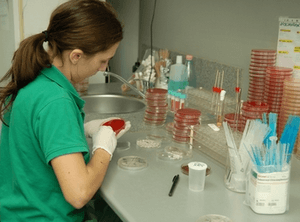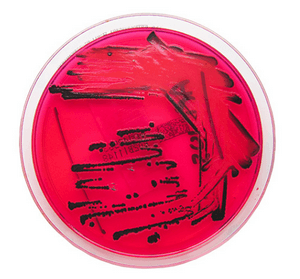 To get rid of an intestinal infection, you need to know the cause of the disease. To do this, the type of pathogen and its sensitivity to antibacterial drugs are determined. Testing for salmonellosis helps identify carriers of the infection and prevent the spread of the disease.
To get rid of an intestinal infection, you need to know the cause of the disease. To do this, the type of pathogen and its sensitivity to antibacterial drugs are determined. Testing for salmonellosis helps identify carriers of the infection and prevent the spread of the disease.
Diagnostic features
Salmonellosis is an infectious disease accompanied by damage to the stomach and intestines. The causative agent is a proteobacterium from the genus Salmonella. Infection occurs after eating contaminated food.
Diagnosis of salmonellosis includes bacteriological, serological and molecular genetic methods. If the digestive system is affected, feces, vomit and stomach contents are examined. After 7 days of illness, salmonella can be detected in the urine. Material for analysis in the septic form of the disease: blood, bile, cerebrospinal fluid.
Laboratory diagnostic methods:
- blood and urine tests (general analysis);
- detection of antibodies to salmonella (ELISA, RNGA);
- bacterioscopy of biological material;
- inoculation on nutrient media to identify the pathogen;
- detection of antigens or genetic material of the pathogen (PCR, RIF, RLA).
Symptoms of salmonellosis are similar to those of other intestinal infections. Differential diagnosis is carried out with diseases such as dysentery, typhoid fever, cholera. This requires specific tests.
Bacteriological culture
The main method of laboratory diagnosis for salmonellosis is the isolation of a pure culture of the bacterium. The study should be carried out at the very beginning of the disease, before treatment with antibiotics. Analysis for salmonellosis can be done in any laboratory.
For diagnostics the following is used:
- Stool culture. It is carried out in a special laboratory. A fresh (morning) portion of stool is required for the study.
- Bacterial culture from the anal canal. A disposable probe is carefully inserted into the rectum using gentle rotational movements. After collecting the material, the probe is delivered to the laboratory in a sterile tube.
- Culture of blood, bile, washing water and other biological material.
The collected material is added to a medium with an admixture of selenite or magnesium, which contains substances useful for all types of salmonella.
The ideal temperature for growing bacteria does not exceed 37 ◦C. How long does the analysis take? The result of sowing can be assessed after 5-6 days. During the study, the type of pathogen, the degree of its activity and the main characteristics are determined.
Analysis for infants
 Testing for intestinal infections in a small child is more difficult than in an adult. To diagnose salmonellosis, fresh stool is required (up to three hours after defecation).
Testing for intestinal infections in a small child is more difficult than in an adult. To diagnose salmonellosis, fresh stool is required (up to three hours after defecation).
It is recommended to take samples from three points on the surface of the disposable diaper. You can't do an enema to get stool. It is necessary to ensure that no urine admixture gets into the sample.
Feces must be placed in a sterile container. The minimum amount of biological sample for research is 5-10 grams. Containers are sold at the pharmacy. The disposable container comes with a special spoon for collecting feces.
Coprogram
This is a laboratory test of stool. Used to determine the degree of damage to the intestinal epithelium. The inflammatory process during salmonellosis is a common cause of digestive disorders.
Pathological changes:
- Leukocytes in large numbers;
- An admixture of undigested fiber;
- Slime;
- Traces of blood;
- Increased starch content.
How to get tested? It is recommended to exclude sweets and products made from premium wheat flour from the patient’s menu. Diet adjustments are made several days before the examination.
Serological study
Modern diagnostics of salmonellosis helps to detect antibodies already 5-7 days after infection. The method is used to determine the stage of disease development and the effectiveness of treatment. The study requires blood sampling from a vein.
How to take a blood test for salmonellosis? The study is carried out in the morning, on an empty stomach. On the eve of the test, it is necessary to exclude heavy physical activity and emotional shocks.
Antibodies to salmonellosis remain in the blood for life. Using serological research methods, you can find out whether a person has had this intestinal infection. The analysis is used to identify the cause of malabsorption syndrome in adults and children.
Polymerase chain reaction
PCR is a genetic study that allows you to identify DNA fragments of Salmonella. It is used for express diagnostics, since the result becomes known within a day.
Preparation:
- The examination is carried out before prescribing antibacterial drugs;
- 3 days before the test, exclude medications based on belladonna (atropine);
- For 73 hours, discontinue medications that change the color of stool (drugs based on bismuth and iron).
The examination is used for differential diagnosis of salmonellosis and preventive regular examinations. Detection of asymptomatic bacterial carriage is very important for preventing the spread of infection.
PCR helps detect salmonellosis at an early stage of development. To do this, a cascade doubling of the genome is carried out using special activator enzymes.
Additional research
 Diagnosis of intestinal infection is very important for determining treatment tactics. After the patient is admitted to the hospital, a full examination is performed. Additional tests are done to assess the patient's condition.
Diagnosis of intestinal infection is very important for determining treatment tactics. After the patient is admitted to the hospital, a full examination is performed. Additional tests are done to assess the patient's condition.
These include:
- General blood analysis. Helps identify the presence of infection and anemia. Characteristic changes: leukocytosis, increased ESR. Determining hematocrit helps assess the degree of dehydration (a high value is a sign of blood thickening).
- General urine analysis. The test is used to diagnose kidney conditions. It is necessary to monitor diuresis. One of the most serious complications of salmonellosis is kidney failure.
- A biochemical blood test allows you to assess electrolyte balance. Unfavorable indicators are an increase in urea and creatinine.
In case of numerous cases of salmonellosis, a bacteriological examination of food is carried out. Salmonella actively multiplies in animal products. These include: meat, eggs, dairy products.
Analysis for the expectant mother
It is advisable to undergo screening for salmonellosis at the planning stage. Salmonellosis is very dangerous for mother and child. Early diagnosis of bacterial carriage will help get rid of the infection before pregnancy.
Examination plan:
- Blood for antibodies to salmonella;
- Mud of PCR;
- Bacterial inoculation from the anus.
Symptoms of intestinal infection are similar to signs of toxicosis, so the initial period of the disease often goes unnoticed. Often a woman is admitted to the hospital in serious condition. Decreased immunity during pregnancy can lead to generalization of infection and the development of Salmonella sepsis.
Modern diagnostic methods will help to detect the infection in time and prevent its spread.
Leave a Reply